- Women prefer and work within hybrid arrangements more frequently than men
- Organizations must ensure hybrid work won’t limit opportunities for women
- High-risk areas for female hybrid workers include growth and recognition
Hybrid work arrangements have evolved to be the norm in most remote-capable workplaces. Flexible work environments were once a perk, but they became a necessity during the pandemic — and are now often viewed as an employee expectation.
Currently, 53% of remote-capable workers have a hybrid work arrangement, and 61% would prefer to work in a hybrid arrangement. With 31% of U.S. employees citing the “option to work remotely from home some of the time” as very important when they consider whether to take another job, it is clear that this change in perspective toward flexible work is here to stay.
When asked what was considered benefits of a hybrid work model, employees told Gallup researchers it was:
- improved work-life balance
- efficient use of time
- more autonomy
- less burnout
- higher productivity
Overall, hybrid workers appreciate the advantages for their overall productivity and wellbeing. Perhaps this explains why women in the workplace — slightly more so than men — seem to gravitate toward and embrace a hybrid work arrangement.
When we look at where employees are getting their work done by gender, women are more likely to currently be working in some form of hybrid work arrangement and to say they would prefer a hybrid arrangement in the future.
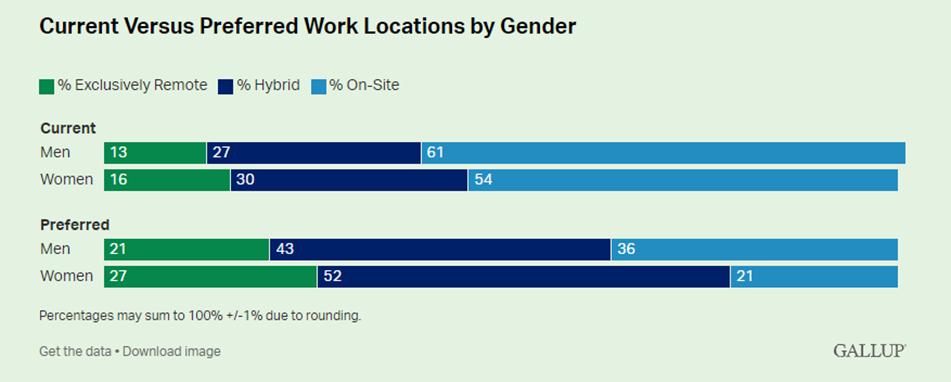
Hybrid and flexible work arrangements are here to stay — something that most employees, especially working women who tend to shoulder more of the primary caregiver and domestic responsibilities, have celebrated as a win.
Working remotely clearly has its advantages — holistic work-life balance, savings of money and time once spent on a commute — but perhaps this new way of working may be costing employees in areas they may not have considered.
Organizational leaders need to be cognizant of the potential cost of this flexibility and whether these costs are steeper for women than they are for men.
How Hybrid Work Can Affect Engagement
Whatever ground the employee engagement trend gained in 2020 has since eroded, with engagement levels now falling below where they were before the pandemic began. When we look at engagement trends by gender, specifically comparing 2019 and 2022, engagement among women is down by four percentage points compared with one point among men. Meanwhile, the percentage of women who are actively disengaged is up three points, compared with one point among men.
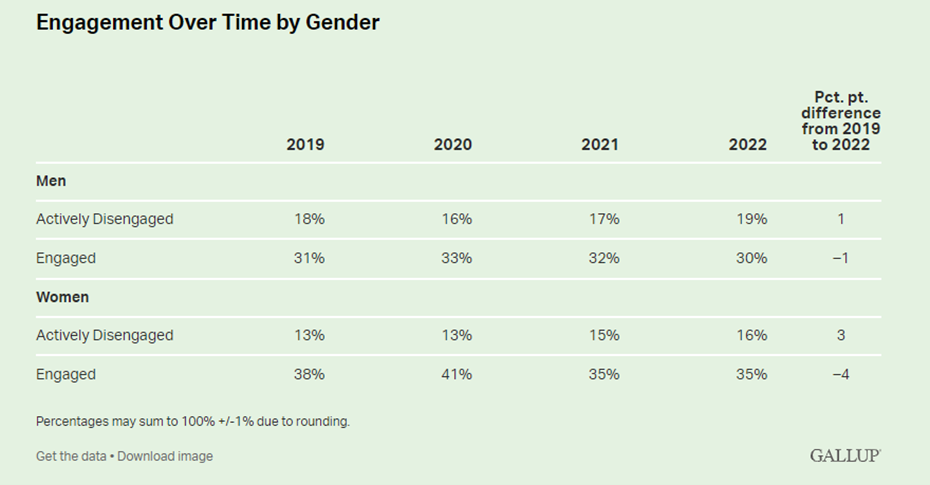
To be clear, it is not that women opting to embrace flexible work arrangements has directly led to an erosion in engagement — but this faltering engagement, and especially the difference between men and women, is worth examining further.
Looking more deeply at the 12 employee needs that Gallup assesses to determine engagement levels, some potential risks of remote work have emerged.
Remote Work Risk No. 1: Networking and Relationship-Building
Historically, women tend to score higher on relationship-based Q12 items such as, “My supervisor, or someone at work, seems to care about me as a person.”
Indeed, more women than men strongly agree that this need is met, but when we look at the decline by gender from 2019 to 2022, we see that women have lost more ground.
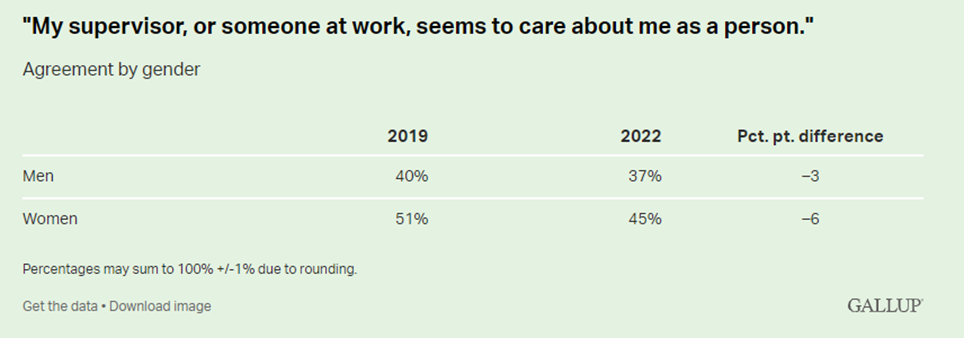
The implication is that relationship-building and network cultivating are areas in which women tend to outperform their male counterparts. However, after the turmoil of the last several years, women are starting to lose ground in these areas. In fact, the same study that saw hybrid workers citing improved overall productivity also found that hybrid work leads to decreased collaboration and coordination challenges with their team-mates.
Beyond feeling cared for at work generally making day-to-day working life more enjoyable, there is something to be said for cultivating a network of partners who will advocate for you whether you are physically in the room or not.
As female workers are embracing flexible work arrangements in higher numbers than their male counterparts, it is important to keep in mind how hybrid work schedules might affect how they experience their working life.
To help mitigate the risk of creating broader gender divides, managers should encourage the women they lead to be intentional about cultivating their network and investing time and effort in relationship-building. For example, women might consider letting on-site and other hybrid co-workers know when they will be in the office or scheduling time to meet with others face-to-face when possible to help nurture relationships.
Leaders can support this effort by modeling these actions themselves, but also by encouraging employees to be intentional and strategic about when and where they collaborate with team members.
Managers, ask yourself:
- How well do each of your team members know one another as people? When you connect, how do you demonstrate you see the human in them first?
- Do you make an effort to connect with your hybrid team members when they are on-site?
- Have you created a team charter to help your team work and collaborate more effectively in a hybrid world?
Remote Work Risk No. 2: Development
One of the most troubling findings about the engagement decline is related to development items by gender — specifically, “There is someone at work who encourages my development,” and, “This last year, I have had opportunities at work to learn and grow.”
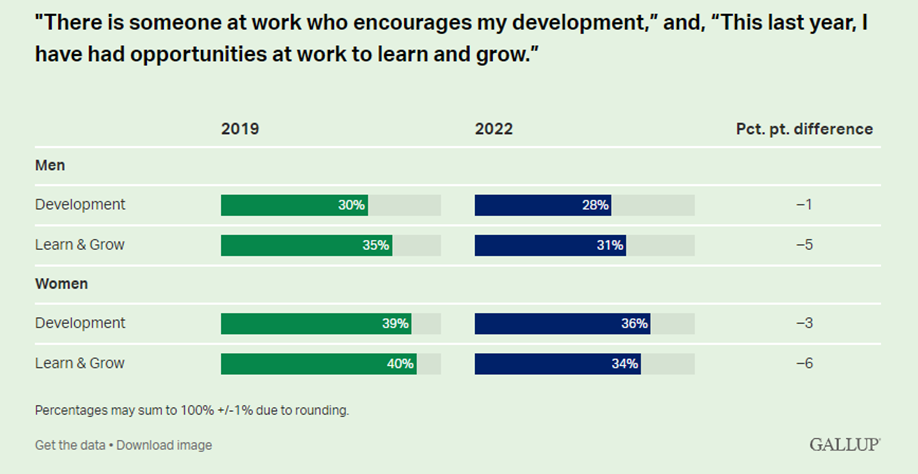
The disparity in the decline of these two measures between men and women is cause for concern. Women’s development needs are still better fulfilled than those of men, as is historically the case. However, women’s experiences with development at work are deteriorating at a faster rate than are men’s.
When we consider that women work remotely at a higher frequency than men do and layer on Deloitte’s finding that 58% of women who are hybrid workers reported feeling they had been excluded from meetings due to being hybrid,1 it is hard to ignore the role that hybrid working may play in affecting development opportunities — especially for women.
Flexible work arrangements are meant to provide an opportunity for true equity in the workplace, no matter the time or place employees do their work. But unfortunately, that is not always the reality women experience — nearly half of female hybrid workers reported that they do not get enough leadership exposure, an arguably necessary element of career advancement.2
At a time when many organizations are embracing DEI initiatives and trying to address the gender gap in executive representation, leaders cannot afford to overlook women’s development and access to mentors and career investors. For this effort to be sustainable, there must continually be women in leadership roles to identify, invest in and support other women’s career advancement.
To help mitigate this risk, managers should use one-on-one connects with the women they lead to discuss projects and development. Asking employees to share the details of current project lists, how things are going and additional helpful context 48 hours before scheduled meetings allows connects to cover more ground than just ticking through a project list. The goal is to have conversations that are more developmentally focused, more frequently.
Leaders can support managers in this effort by intentionally discussing development more often with their direct reports and continually reminding the organization of the power and efficacy of meaningful conversations.
Managers, ask yourself:
- When was the last time you had a one-on-one with each of your on-site, remote and hybrid team members? Did you discuss their development needs?
- How well do you know your team members’ goals and aspirations? When did you last check in to confirm these are still accurate?
- How do you ensure that everyone on your team is fulfilled and growing in their role?
Remote Work Risk No. 3: Recognition
Employees who receive fulfilling recognition are up to 90% less likely to report being burned out at work “always” or “very often.” These employees are also about 40% less likely to report having experienced a lot of stress, worry and sadness. Recognition enhances the modern workplace, which is why it is so critical that business leaders and organizations get it right.
Getting recognition right can be challenging when the work happens outside of the office or outside of typical working hours. Whether you look at current work location, preferred work location or where employees anticipate they will work in the future, men are much more likely than women to say they will work on-site. If recognition focuses solely on work completed in a traditional location, the successes of your hybrid workers (who are more likely to be women) can be overlooked.
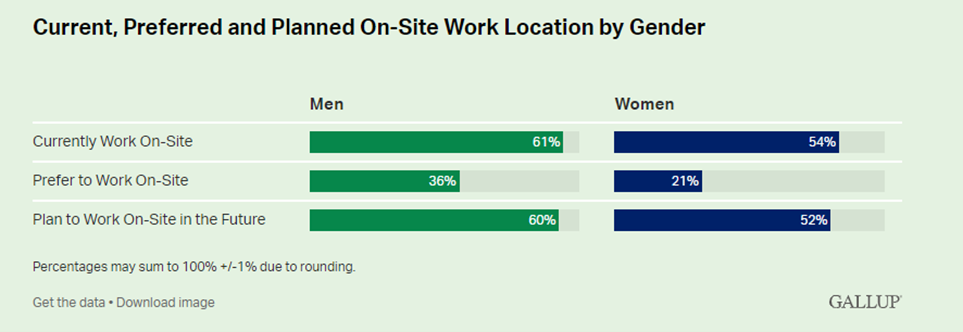
Given this trend, it is important that employees and managers alike guard themselves against proximity bias and an “out of sight, out of mind” mentality. To mitigate this risk, leaders should encourage women to highlight or amplify their successes and visibility for projects that they complete outside of regular working hours or locations.
Leaders and career investors for women can also make it a point to seek out and celebrate accomplishments from other women, regardless of where or when they get their work done. After all, a rising tide lifts all ships. Our capacity to give recognition, like experiencing gratitude, is endless.
Managers, ask yourself:
- How well do your employees know what their expectations and targets are?
- How often do you acknowledge great work? How do you praise it?
- How do you help employees set their priorities and know how to get the best ROI for their efforts?
This new world of hybrid work grants many the freedom to work when and where it suits them best. For many, getting the right balance will be an ongoing pursuit, and there is no right or wrong answer when it comes to hybrid work schedules. It is simply about what works for individuals, their circumstances, their role and the organization.
As we settle in and notice the ripple effects of this shift in how and where we work, it is important to take stock of those changes and acknowledge the risks that hybrid work can present to all employees, especially working women. If equity is truly the goal, leaders and managers must be intentional and proactive in helping support hybrid working women’s efforts to brace against the potential risks of hybrid work.
Create a successful organization through successful women.
- Progress is not possible without women. Check out our International Women’s Day page to learn about women’s experiences and how to support them.
- Learn how to create a workplace culture that attracts, engages and retains a gender-diverse workforce with our report on Women in America.
- Discover how to care for hybrid employees and keep remote teams engaged with Gallup’s guide.
Camilla Frumar is a Senior Consultant for Gallup in Sydney.
Anna Truscott-Smith is a Senior Research Consultant for Gallup in London.
Jessica Schatz is a Content Writer at Gallup.
Survey Methods and References
2019 Gallup Workforce Study: Combining survey responses from 14,174 full-time employees (excluding self-employed) conducted between January-December 2019. Margin of error was ±1 percentage point.
2020 Gallup Workforce Study: Combining survey responses from 13,592 full-time employees (excluding self-employed) conducted between January-December 2020. Margin of error was ±1 percentage point.
2021 Gallup Workforce Study: Combining survey responses from 37,395 full-time employees (excluding self-employed) conducted between January-December 2021. Margin of error was ±1 percentage point.
2022 Gallup Workforce Study: Combining survey responses from 60,799 full-time employees (excluding self-employed) conducted between January-December 2022. Margin of error was ±1 percentage point.
Results for this Gallup poll are based on self-administered web surveys conducted Oct. 26-Nov. 4, 2022, with a random sample of 18,655 adults who are aged 18 and older, working full time or part time for organizations in the United States, and members of the Gallup Panel. For results based on this sample, the margin of sampling error is ±1.1 percentage points at the 95% confidence level.
[1][2] Deloitte. (2022). Women @ Work 2022: A Global Outlook. https://www2.deloitte.com/content/dam/Deloitte/global/Documents/deloitte-women-at-work-2022-a-global-outlook.pd









